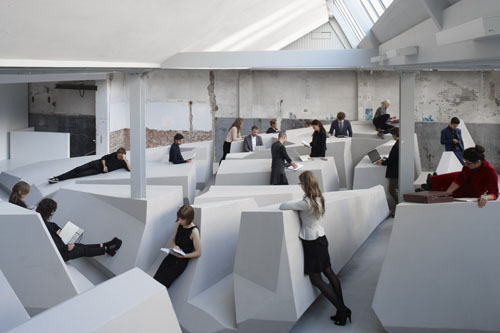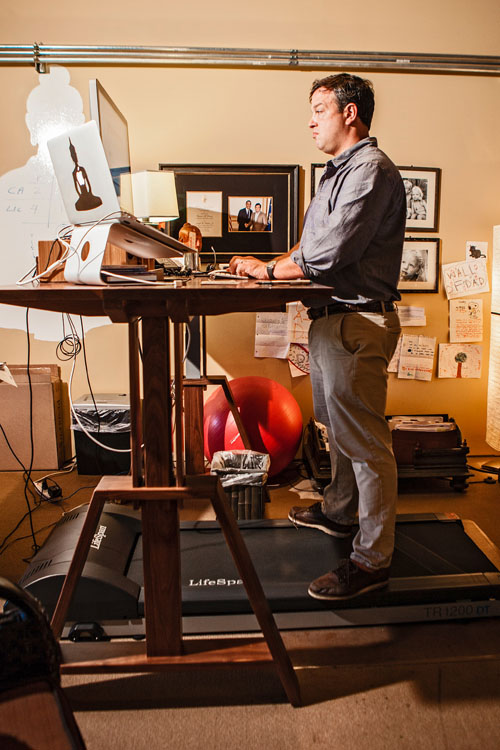BY AMY MILSHTEIN | OB CONTRIBUTOR
Don’t just sit there. For a healthy workplace, move up and down — and all around.
BY AMY MILSHTEIN | OB CONTRIBUTOR
Don’t just sit there. For a healthy workplace, move up and down — and all around.
David Howitt, CEO of The Meriwether Group, at his custom-built standing desk. |
Chairs are the new cigarettes, claim countless articles about health and the sedentary lifestyle. Evidence links prolonged sitting to the rising incidence of cancers, diabetes and cardiovascular disease, not to mention tight hips, rounded shoulders, stiff backs and pudgy middles. Yet workplace demands bind employees to their desks for eight hours a day or more. So what’s a hard-working, health-conscious person to do? Enter the standing desk.
Standing desks have been around for a long time. Thomas Jefferson, Napoleon Bonaparte, Charles Dickens and Winston Churchill all used standing desks, according to the oddly obsessive NotSitting.com. Today’s furniture companies offer contemporary versions.
The models are popular, especially here at home. David Jones, chief information officer of furniture maker Anthro, reports that half its workstation sales are sit-stand solutions, and Oregon ranks as one of the top three markets for the products. (Anthro was recently purchased by Rhode Island-based Nortek but continues operations out of its Tualatin headquarters and factory.)
So is that the answer? Quit sitting cold turkey and we’ll stave off obesity and cancer while fathering a nation and saving Europe from the Nazis?
Not quite. Turns out standing comes with its own set of risks. “Plantar fasciitis, ankle pain and other musculoskeletal issues are all side effects of prolonged standing,” says Dr. James Chesnutt, medical director of the OHSU sports medicine program. Even the weight-loss opportunity is negligible. “There is not a significant difference in calorie burn between sitting and standing,” reports OHSU March Wellness and Fitness Center director Carl Davison.
The real benefit of adjustable desks, explains Dr. Chesnutt, comes from changing positions throughout the day. “Mixing your mode of work is the best strategy,” he says. While he can’t give an optimal number of hours to stand versus sit, he does say that any intervention that decreases sedentary time is a worthy one. “There was a good study done in Australia showing that people who used to sit for an average of 85% of their day decreased that time to 60% after moving to an adjustable desk,” he says.
Adjustable desks also allow users to slowly ramp up their standing time. “You have to condition your way into standing if you’re not used to it,” says Davison.
The market has recognized this niche and filled it with an assortment of movable products that let workers sit or stand at a variety of price points. “We have solutions that range from a couple of hundred dollars to $1,800,” states Jones. The higher- end products offer quality work surfaces, better warranties and speed. Some of the company’s products “move to standing in a matter of seconds,” Jones says.
Or you could totally geek out with the TableAir. This product from the U.K. syncs to your phone so you can program a sit-stand schedule or remotely adjust the color of the LED-embedded side panels. But that’s not the coolest feature. The TableAir includes a sensor that reads the height of your outstretched hand and rises to meet it. Price tag: $2,200.
Which invites the question: Will insurance pay for this? Jones could not find an instance in Anthro’s records that indicated an insurance company ponied up for the equipment. Dr. Chesnutt isn’t sure it should. “If you have a work-related injury, then it might be reasonable, but I don’t think there’s enough evidence for this intervention. I would prefer to see insurance pay for gym memberships.”
Chesnutt still thinks that the adjustable desk adds value to the employer-employee relationship. “Anything that helps workers mix up their positions, not get bored and avoid injuries caused by oversitting is worth it,” he says. “The mental health aspects shouldn’t be overlooked.”
At some point, however, the trend turns into a fad. There are already treadmill desks, stationary bicycle desks, and even elliptical machine desks which just seem counterproductive and silly. It’s enough to send you to your bed, where, for $128, you could strap your laptop to a Japanese-made folding desk that lets you work while lying down.
Sweet dreams.
The leaning desk

Dutch firm RAAAF is working on a futuristic office design that eschews desks and chairs. “We said what if we could create a work environment which is not based on tables and chairs anymore?” co-founder Ronald Rietveld told Fast Company magazine in December. The dynamic design features giant, rock-like sculptures that allow people to lean in different positions throughout the day. RAAAF is working with health researchers to study the impact of the new design on health and wellness.
{jcomments on}



